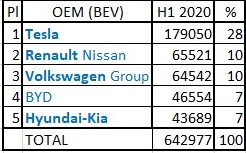Thanks. This is helpful.SEAT and Skoda sold 2300 rebadged e-Ups in NL+NO+SP through June, and I presume some in the rest of Europe. I figure VW Group sold 105k+ EVs in 1H 2020. As you note they are far behind Tesla, who is ramping. But VAG also has some 2H cards to play:
- ID.3, which they are building but not yet selling
- Two 300k EV factories in China coming online this fall
It seems EU and China mandates originally required VW to sell 300k+ EVs in the 2nd half, and they've built capacity for it. Plus they'll sell a few thousand Taycans and such in the US and elsewhere. COVID is a wildcard, though. By decimating ICE sales it also reduces the number of EVs that VW and others must sell to meet the mandates. Once VW clears their 2020 hurdle it makes sense to delay further deliveries until January. That could cap them at 300-350k vs. the 425-450k in their original plan. That's why I say the #1 slot is a long shot.
Even if they did beat Tesla I don't think it will affect market cap. VW is valued as a carmaker, not a tree growing to the sky.
You point out something many people overlook, that as ICE sales decline, the mandated number of EVs to sell also decline. This why apart from Tesla EVs sales are generally declining too. Anti-EV people are quick to highlight declines in EVs sales to argue that people don't really want them. But this ignores that most EVs sold are still largely a compliance play.
So what do we make of VW? If they have the capacity, but the compliance hurdle falls with ICE sales, what do they do? If they are not turning a profit on these vehicles apart from compliance value, then they reduce production. If demand is not strong, sales also wane. So it it not clear if they are demand constrained or compliance constrained. If, on the other hand, demand was strong with these vehicles priced at a healthy margin, then of course they would sell as many as they could produce.
It's a tough year for everyone, but I suspect that these vehicles are not profitable to grow much beyond compliance dictated levels. If that is the case, they really are not yet competing with Tesla. They might only be near the top of the EV list because selling EVs is a cost of doing business as automaker.




